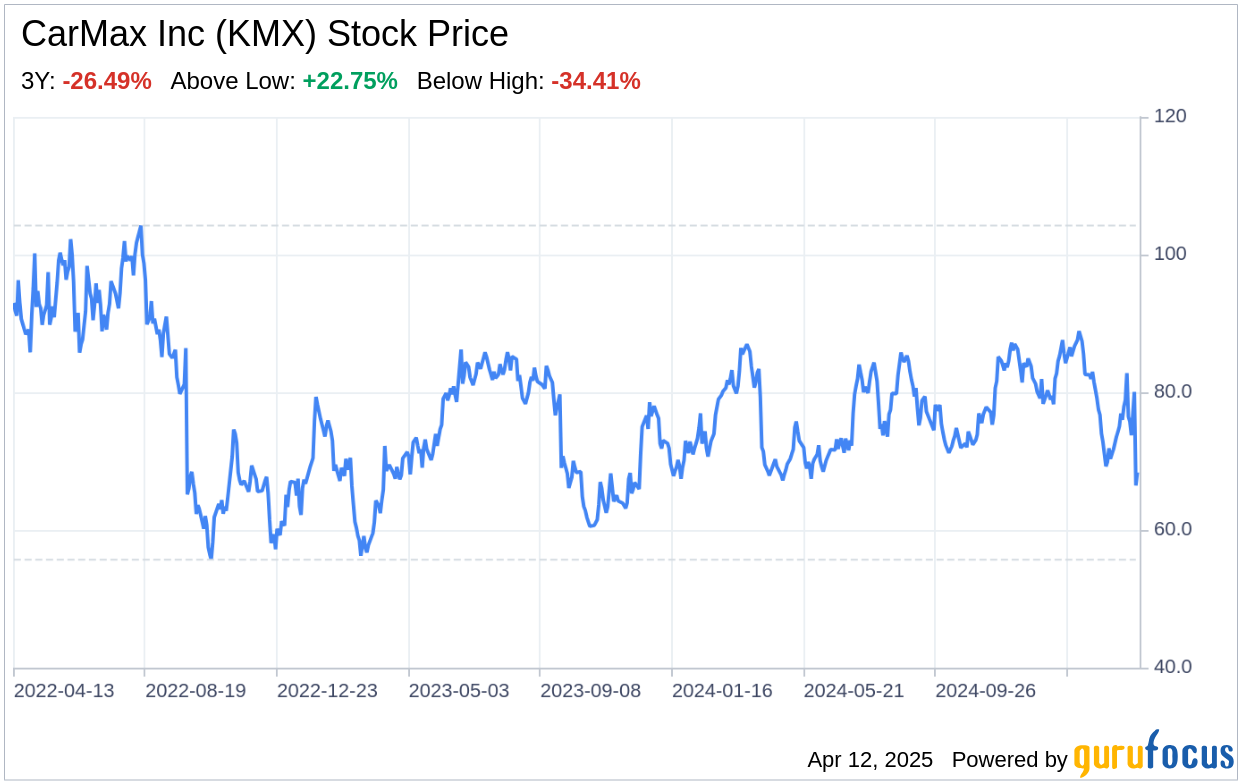On April 11, 2025, CarMax Inc (KMX, Financial), the nation's largest retailer of used vehicles, filed its 10-K report, revealing a comprehensive overview of its operations and financial performance for the fiscal year ended February 28, 2025. With a chain of approximately 250 retail stores, CarMax Inc has established a strong presence in the used car market, accounting for about 83% of its revenue from used-vehicle sales. Despite a challenging year due to the chip shortage, the company managed to retail and wholesale 765,572 and 546,331 used vehicles, respectively. The financial tables within the filing indicate a solid balance sheet, with cash equivalents of $126.9 million as of February 28, 2025, and a market capitalization of $13.1 billion as of August 31, 2024. This SWOT analysis aims to dissect the intricate details of CarMax Inc's financial filings and provide insights into the company's strategic positioning.

Strengths
Brand Recognition and Customer Experience: CarMax Inc (KMX, Financial) has cultivated a strong brand image and customer loyalty through its no-haggle pricing and customer-friendly sales process. The company's omni-channel experience, which allows customers to seamlessly buy cars online or in-store, has been a significant differentiator in the market. With an average of 35 million monthly visits to its website and mobile app during fiscal 2025, CarMax has demonstrated its ability to attract and engage customers digitally. Approximately 95% of customers who purchased a vehicle first visited online, and about 80% utilized digital capabilities to complete their transactions, underscoring the effectiveness of CarMax's digital strategy.
Proprietary Technology and Data Science: CarMax's investment in proprietary technology platforms, including advanced data science, AI, and machine learning capabilities, has optimized its business operations and customer experience. The company's centralized inventory management and pricing system have enabled it to maintain pricing discipline and optimize inventory turns, reducing depreciation risk. This systematic approach has resulted in 99% of its used car inventory being sold at retail, highlighting the strength of CarMax's inventory management strategy.
Weaknesses
Competitive Industry Landscape: Despite its strong market position, CarMax Inc (KMX, Financial) operates in a highly competitive and fragmented industry. The company faces competition from new and used car dealers, online and mobile sales platforms, and private sellers. Competitors have replicated aspects of CarMax's consumer offer, and new entrants with online-focused business models pose a threat to CarMax's market share. The company must continuously innovate and adapt to maintain its competitive edge, which can be resource-intensive and challenging.
Dependence on Economic Conditions: CarMax's business is sensitive to national and regional economic conditions, such as recession, inflation, interest rates, and consumer credit availability. Economic downturns can adversely affect consumer demand for vehicles, vehicle affordability, and credit availability for vehicle purchases. These factors can lead to lower sales, decreased margins, and reduced profitability for CarMax, making it vulnerable to economic fluctuations.
Opportunities
Market Expansion and Partnerships: CarMax Inc (KMX, Financial) has the opportunity to expand its market share beyond the current 3.7% of the US market for vehicles 0-10 years old. By opening new locations and forming strategic partnerships, CarMax can reach new customer segments and geographies. The company's naming rights agreement for the new ballpark in Richmond, Virginia, and expanded partnerships with the WNBA and NWSL demonstrate its commitment to brand building and community engagement, which can drive future growth.
Technological Advancements: The continued development of CarMax's technology platforms and strategic initiatives, such as the integration of Edmunds' operations, presents opportunities to enhance the customer experience and streamline operations. CarMax's ability to leverage data automation, AI, and machine learning can lead to more personalized customer interactions and efficient business processes, positioning the company to capitalize on the growing trend of digital car buying and selling.
Threats
Regulatory and Legal Challenges: CarMax Inc (KMX, Financial) operates in a highly regulated industry, with a wide range of federal, state, and local laws governing its business practices. Compliance with these regulations, including consumer protection, privacy, and environmental laws, can be costly and complex. Any failure to comply could result in significant penalties, fines, or reputational damage, posing a threat to CarMax's operations and financial health.
Technological Disruption: The automotive industry is undergoing rapid technological changes, with increasing demand for electric vehicles (EVs), autonomous vehicles, and new business models like subscription services. CarMax must adapt to these changes to remain relevant and competitive. Failure to effectively respond to technological advancements and evolving consumer preferences could have a material adverse effect on CarMax's business and market position.
In conclusion, CarMax Inc (KMX, Financial) exhibits significant strengths in brand recognition, customer experience, and proprietary technology, which have solidified its position as a leader in the used vehicle market. However, the company must navigate a competitive landscape, economic sensitivities, and regulatory complexities. Opportunities for growth through market expansion and technological advancements are promising, but CarMax must remain vigilant against threats from regulatory challenges and industry disruption. By leveraging its strengths and addressing its weaknesses, CarMax can capitalize on opportunities and
This article, generated by GuruFocus, is designed to provide general insights and is not tailored financial advice. Our commentary is rooted in historical data and analyst projections, utilizing an impartial methodology, and is not intended to serve as specific investment guidance. It does not formulate a recommendation to purchase or divest any stock and does not consider individual investment objectives or financial circumstances. Our objective is to deliver long-term, fundamental data-driven analysis. Be aware that our analysis might not incorporate the most recent, price-sensitive company announcements or qualitative information. GuruFocus holds no position in the stocks mentioned herein.
